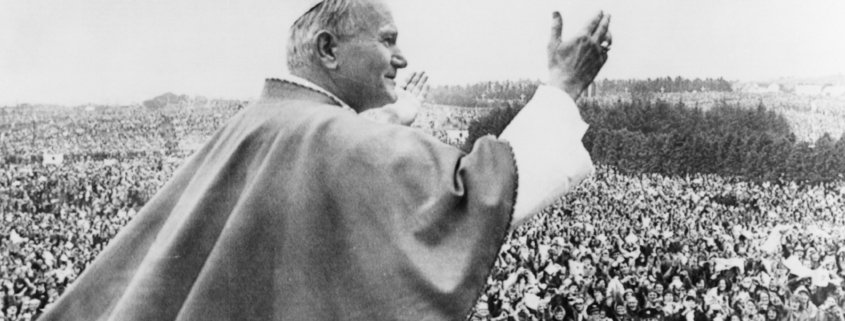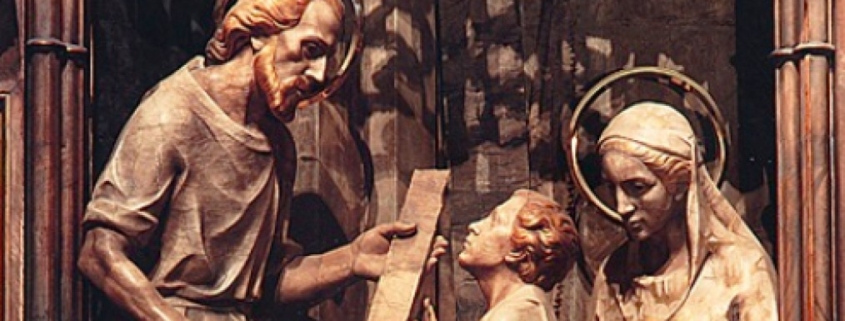On this Feast of St Joseph the Worker, let’s take a look at where Jesus grew up, working with St Joseph. What kind of work, exactly, did they do, and what sort of projects did they work on? How did the place Jesus grew up influence his teaching? You might be surprised!
My favorite basketball player growing up was the legendary Larry Bird of the Boston Celtics. The media (and Larry himself) liked to play up his humble, small-town roots, dubbing him the “Hick from French Lick,” the small Indiana town where Bird grew up. He was just a kid from the sticks who made good.
For centuries, preachers have similarly accented the alleged small-town roots of Jesus. Nazareth, where Jesus grew up, is usually portrayed in homilies as a type of isolated backwater, far removed from the hustle and bustle of the empire.
Now, it’s certainly true that in Jesus’ day Nazareth was relatively tiny, with a population somewhere between 200 and 400. But recent archaeological excavations around Nazareth, which today is a relatively bustling city of about 60,000, have quashed the quaint myth that Jesus grew up among “country bumpkins” removed from major centers of commerce and culture.
One of the most important of these digs took place at Sepphoris, which is located about four miles north of Nazareth. Sepphoris, which Roman historian Josephus called “the ornament of all Galilee,” was the largest and one of the most important cities in the area. In fact, a highway linking the two other major regional centers—Caesarea Maritima and Tiberias—was not far from Nazareth and Sepphoris.
Considering its proximity to Nazareth, it’s highly likely that Jesus would have traveled to Sepphoris on many occasions. In fact, according to an early Church tradition, the Blessed Virgin Mary hailed from Sepphoris. One could easily imagine Jesus, Mary, and Joseph making the trip to see Jesus’ grandparents, Joachim and Anne, on many an occasion.
It is also possible that Joseph and Jesus worked in Sepphoris during its period of heavy expansion under Herod Antipas from 4 B.C. to A.D. 39. The Greek word tekton—which the Gospels employ to describe Jesus’ and Joseph’s occupation—actually means much more than “carpenter.” It refers to a highly skilled laborer who would have been proficient in working with stone as well as wood and other materials. (In fact, it is likely that Joseph and Jesus would have had architectural abilities as well. One might even say they were the equivalent of modern-day engineers.) Antipas had originally intended to make Sepphoris his headquarters, and he installed some beautiful architecture there in the Greco-Roman style, including magnificent colonnaded streets and an impressive theater (more on that later).
The Sepphoris excavations are also important for debunking a popular skeptical theory. The scholar (and ex-Catholic priest) John Dominic Crossan argues that, in his early life, Jesus came under the sway of itinerant Cynic philosophers in Sepphoris who greatly influenced his teaching. But excavations at the city dump have determined that, at the time of Jesus, Sepphoris’s inhabitants were anything but pagan.
Only in strata (layers of cultural remains in the earth, representing different eras) dated after A.D. 70 do we find pig bones and other evidence of Hellenizing influences, consistent with growth in the city’s non-Jewish population following the failed Jewish revolt of 66-70. It seems the citizens of Sepphoris in Jesus’ time kept to a kosher diet.
Furthermore, coins minted in Sepphoris prior to 70 do not depict the image of the emperor as a deity, which would have offended devout Jews, even though such currency was common elsewhere in the empire. After the year 70, this is not the case. Also, stone vessels and miqva’ot (ritual bathing pools) used for Jewish purification rites, as well as menorahs, have also been found from the pre-70 period.
In short, Sepphoris was in all likelihood a mostly—if not completely—Jewish city at the time of Jesus. It is therefore improbable that Jesus came under the sway of pagan Cynics during his early life in and around Nazareth. His teaching, like the area he hailed from, was thoroughly Jewish.
Sepphoris is also a potential boon for understanding and clarifying certain aspects of Jesus’ teachings. We know that Jesus was a master at pointing out profound lessons from the everyday world (for example, his many agricultural parables). I believe there is a high probability that Sepphoris was a part of that world and that it figures prominently in Jesus’ preaching—especially as recorded in the Gospel of Matthew. The “city set on a hill [that] cannot be hidden” (Matt. 5:14) may have been inspired by Sepphoris, which was elevated. Its evening lights would have been visible to the inhabitants of Nazareth.
Excavations at Sepphoris also reveal a splendid public theater, carved out of the local bedrock and initially seating about 2,500. Could it be that Jesus and Joseph worked on its construction? But Jesus’ references to “hypocrites” (Matt. 6:2, 5, 16; 7:5; 15:7; 16:3; 22:18; 23:13-15, 23, 25, 27-29; 24:51; Luke 6:42; 11:44; 12:1, 56; 13:15), an originally innocuous word that referred to “actors” or “play-actors,” may have been expropriated from the theater at Sepphoris. Jesus used the term to excoriate the people-pleasing, insincere piety of some scribes and Pharisees.
Jesus likewise admonishes his disciples not to practice their piety “before people, in order to be seen by them” (Matt. 6:1). The term translated as “to be seen” is the Greek word theathenai, from which we derive the English word theater. Jesus teaches his followers not to “be like the hypocrites; for they love to stand and pray in the synagogues and at the street corners, so that they may be seen by others” (Matt. 6:5). This may allude to an actor who stands and performs a soliloquy on stage.
In contrast, Jesus encourages us to live not for the applause of others but rather for the applause of One: God alone.
Church Fathers, such as St. Jerome, referred to the Holy Land as the “Fifth Gospel” because it helps put the life of Jesus in context. It helps us to understand many of Jesus’ teachings and activities. It also helps us understand how the four written, canonical Gospels are indeed trustworthy, because they exhibit verisimilitude—that is, that they cohere with the way things actually were in the Israel of Jesus’ day. That’s why archaeological discoveries like those at Sepphoris shed so much light on the teachings of Christ.
Note: This post was originally published as “Lessons From Big-City Jesus”.





